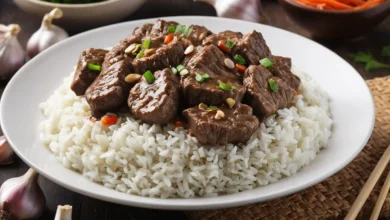Soondubu Jjigae Recipe: How to Make Korean Spicy Soft Tofu Stew at Home

Soondubu Jjigae (순두부찌개), also known as Korean spicy soft tofu stew, is a beloved dish among Korean food enthusiasts. Packed with bold flavors, this comforting stew features soft tofu, a rich and spicy broth, and an assortment of meats or seafood, making it a popular choice for cold weather or whenever you need a hearty, satisfying meal. Known for its unique, silky texture and punchy flavors, Soondubu Jjigae is relatively easy to make and can be customized to suit different preferences and spice levels.
In this guide, we’ll walk you through an authentic Soondubu Jjigae recipe, complete with tips for perfecting the broth, selecting ingredients, and serving this delicious stew just like in Korean restaurants.
What Is Soondubu Jjigae?
Soondubu Jjigae, or Korean spicy soft tofu stew, is a Korean soup dish that primarily consists of uncurdled tofu (soondubu), vegetables, and a protein of choice, all simmered in a spicy gochugaru (Korean chili powder) broth. It’s usually served bubbling hot, often with a raw egg added just before serving, adding richness to the already flavorful broth.
Frequently Asked Questions About Soondubu Jjigae
- What does Soondubu mean? “Soondubu” refers to very soft, uncurdled tofu, also known as silken tofu, used in this stew.
- Is Soondubu Jjigae very spicy? It can be! You can adjust the spiciness by adding less gochugaru (Korean chili powder) or substituting it with milder chili flakes.
- Can I make Soondubu Jjigae vegetarian? Absolutely. Swap the meat or seafood with extra mushrooms and use vegetable broth for a vegetarian-friendly version.
- What is traditionally served with Soondubu Jjigae? Soondubu Jjigae is commonly served with steamed rice and various Korean side dishes (banchan), such as kimchi, pickled radishes, and seasoned vegetables.
- Is it okay to crack a raw egg into Soondubu Jjigae? Yes! Adding a raw egg just before serving enriches the broth and provides a wonderful creamy texture when stirred in.
How to Make Authentic Soondubu Jjigae: Step-by-Step Recipe
Ingredients
- 1 pack (14 oz) silken tofu (soft tofu)
- 4 oz pork belly or beef, sliced thinly (or seafood such as shrimp and clams)
- 1 tbsp sesame oil
- 1 tbsp gochugaru (Korean chili powder)
- 1/2 tbsp gochujang (Korean chili paste)
- 2 cups dashi or chicken broth (or anchovy broth for authentic flavor)
- 1 small onion, sliced
- 2 cloves garlic, minced
- 1 green onion, chopped
- 1/4 cup kimchi, chopped (optional for added flavor)
- Salt and pepper, to taste
- 1 egg (optional, for garnish)
- 1 green chili pepper, sliced (optional for additional heat)
- Steamed rice (for serving)
Instructions
- Prepare the Broth Base: Heat a Korean clay pot (ttukbaegi) or medium-sized pot over medium heat. Add sesame oil, allowing it to warm up, then add the gochugaru (Korean chili powder). Stir for about 1 minute, allowing the chili powder to infuse the oil with flavor, creating a fragrant base for the stew.
- Add Gochujang and Aromatics: Add the gochujang (Korean chili paste), minced garlic, and onion slices to the pot. Sauté everything together for 2–3 minutes until the garlic is fragrant and the onions start to soften.
- Add the Meat or Seafood: Incorporate the sliced pork belly (or beef) into the pot, stirring it to coat the meat in the spicy base. Cook for 3–4 minutes until the meat begins to brown. If you’re using seafood, add it later with the tofu to prevent overcooking.
- Pour in the Broth: Add the dashi, chicken, or anchovy broth to the pot and bring it to a gentle boil. If using kimchi, add it at this stage for added depth and flavor. Let the stew simmer for about 10 minutes.
- Add the Tofu: Gently add the silken tofu to the pot in large spoonfuls, being careful not to break it apart too much. Silken tofu’s delicate texture is central to Soondubu Jjigae, so handle it gently.
- Adjust Seasoning: Taste the broth and season with salt and pepper as needed. You may also adjust the spice level by adding extra gochugaru if you prefer more heat.
- Simmer and Add Egg: Allow the stew to simmer for another 5–7 minutes until all the ingredients are heated through. If you’re adding an egg, carefully crack it into the center of the pot just before serving. The residual heat will gently cook the egg, adding richness to the dish.
- Garnish and Serve: Top with sliced green onion and green chili pepper if desired. Serve the bubbling hot Soondubu Jjigae with a bowl of steamed rice and your favorite Korean side dishes.
Delicious Variations of Soondubu Jjigae
- Seafood Soondubu Jjigae: Substitute pork or beef with seafood like clams, mussels, and shrimp. Seafood Soondubu Jjigae is common in coastal areas of Korea and has a light, briny flavor.
- Kimchi Soondubu Jjigae: For a punch of umami, add a generous amount of kimchi to the stew. The tangy, fermented flavors of kimchi pair perfectly with the soft tofu and spicy broth.
- Vegetarian Soondubu Jjigae: Use vegetable broth and load the stew with mushrooms, zucchini, and other vegetables. It’s a flavorful, plant-based option that doesn’t compromise on taste.
- Cheese Soondubu Jjigae: Add a slice of cheese (such as cheddar) just before serving for a creamy, slightly salty twist. The melted cheese complements the spicy broth and adds a comforting richness.
Health Benefits of Soondubu Jjigae
Soondubu Jjigae is not only delicious but also nutritious. Tofu is high in protein and low in calories, making it an excellent choice for those looking to maintain a healthy diet. The gochugaru and gochujang used in the stew contain capsaicin, known to boost metabolism and provide anti-inflammatory benefits. When combined with vegetables and lean proteins, Soondubu Jjigae makes a balanced, nutrient-rich meal.
Tips for the Perfect Soondubu Jjigae
- Choose Fresh Tofu: The quality of tofu significantly impacts the stew. Use fresh, silken tofu for a soft and creamy texture.
- Use Authentic Korean Ingredients: Gochugaru and gochujang provide the authentic flavors and color for Soondubu Jjigae. Look for these at Korean markets or online to capture the traditional taste.
- Add Kimchi for Depth: Adding a small amount of chopped kimchi to the broth can enhance the flavor and give your stew a slightly tangy, umami kick.
- Cook in a Clay Pot: For an authentic Korean dining experience, cook and serve Soondubu Jjigae in a ttukbaegi (Korean clay pot), which retains heat and keeps the stew bubbling hot at the table.
- Serve with Side Dishes: Soondubu Jjigae is traditionally served with rice and a variety of banchan (Korean side dishes), such as kimchi, pickled radish, and spinach salad, to balance the flavors and provide a complete meal experience.
Conclusion
Soondubu Jjigae is the perfect dish for anyone seeking a flavorful, hearty, and comforting meal. Its rich, spicy broth and tender tofu create a wonderful balance of textures and flavors, making it a popular choice both in Korea and worldwide. By following this recipe, you can enjoy an authentic Soondubu Jjigae experience in the comfort of your home. Whether you’re making it mild or spicy, with seafood or beef, this dish is guaranteed to warm you up and satisfy your taste buds. Try out this recipe, customize it to your liking, and savor the bold, delicious flavors of Korean cuisine.





